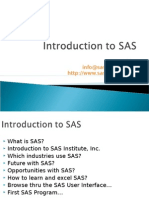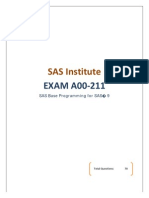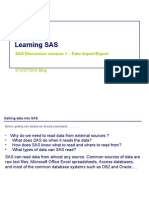100%(1)100% found this document useful (1 vote)
6K viewsMerging Data Seven Different Ways
This document discusses 7 different methods for merging data in SAS:
1. Using the MERGE statement in a DATA step, which is the most common approach.
2. Using PROC SQL to perform the merge.
3. Using two SET statements and the KEY= option to loop through and find matches.
4. Creating a format from one dataset and using it to add variables when reading the other dataset.
5. Using hash tables since SAS 9.1 to perform the merge.
6. Loading one dataset into an array, then using the array to attach variables when reading the second dataset.
7. Using a MODIFY statement to update one dataset with variables from the other and outputting to
Uploaded by
sarath.annapareddyCopyright
© Attribution Non-Commercial (BY-NC)
Available Formats
Download as PDF, TXT or read online on Scribd
100%(1)100% found this document useful (1 vote)
6K viewsMerging Data Seven Different Ways
This document discusses 7 different methods for merging data in SAS:
1. Using the MERGE statement in a DATA step, which is the most common approach.
2. Using PROC SQL to perform the merge.
3. Using two SET statements and the KEY= option to loop through and find matches.
4. Creating a format from one dataset and using it to add variables when reading the other dataset.
5. Using hash tables since SAS 9.1 to perform the merge.
6. Loading one dataset into an array, then using the array to attach variables when reading the second dataset.
7. Using a MODIFY statement to update one dataset with variables from the other and outputting to
Uploaded by
sarath.annapareddyCopyright
© Attribution Non-Commercial (BY-NC)
Available Formats
Download as PDF, TXT or read online on Scribd
You are on page 1/ 1
Merging Data Seven Different Ways
David Franklin, Independent Consultant, New Hampshire, USA
Abstract Hash Tables
Merging data is one of the fundamental functions carried out when manipulating data 5 Since SAS version 9.1, the use of hash tables to merge data has been
to bring it into a form for either storage or analysis. The use of the MERGE statement available.
inside a datastep is the most common way this task is done within the SAS language DATA alldata0;
but there are others. This paper looks at the seven possible methods, including the IF _n_=0 THEN SET patdata;
use of the MERGE statement, for a one to one, or one to many merge, introducing the IF _n_=1 THEN DO;
SAS code needed to combine the data. No one method is better than another but DECLARE HASH _h1 (dataset: "PATDATA");
some pointers will be given on choosing a method for your data. rc=_h1.definekey("SUBJECT");
rc=_h1.definedata("TRT_CODE");
Introduction rc=_h1.definedone();
call missing(SUBJECT,TRT_CODE);
Merging variables from one dataset into another is one of the basic data manipulation END;
tasks that a SAS SET adverse;
programmer has to do. The most common way to merge on data is using the MERGE rc=_h1.find();
statement in the DATA step but there are six other ways that can help. First though, IF rc^=0 THEN trt_code=" ";
some data: DROP rc;;
RUN;
Dataset: PATDATA
SUBJECT TRT_CODE
Loading Unique Dataset into an Array
124263
124264
A
A
6 Unique dataset is put into an array first, then array is used to attach
124265 B TRT_CODE to ADVERSE when reading dataset ADVERSE in.
124266 B DATA _null_;
Dataset: ADVERSE SET sashelp.vtable;
SUBJECT EVENT WHERE libname='WORK';
124263 HEADACHE WHERE ALSO memname in('PATDATA','ADVERSE');
124266 FEVER CALL SYMPUT('X'||memname,put(nobs,8.));
124266 NAUSEA DATA alldata0;
124267 FRACTURE LENGTH trt_code $1;
ARRAY f{&xpatdata.,2} $6 _TEMPORARY_;
This data will be used throughout the poster for each method described. DO i=1 TO &xpatdata.;
SET patdata (RENAME=(trt_code=trt_code_dict));
f{i,1}=PUT(subject,6.); f{i,2}=trt_code_dict;
MERGE Statement
1 Most common code used to merge data – maximum control but data must be
END;
DO i=1 TO &xadverse.;
sorted or indexed before DATA statement. SET adverse;
DATA alldata0; trt_code='';
MERGE adverse (in=a) patdata (in=b); DO j=1 TO &xpatdata.;
BY subject; IF subject=INPUT(f(j,1),best.) THEN DO;
IF a; trt_code=f{j,2}; OUTPUT;
RUN; END;
IF ^MISSING(trt_code) THEN LEAVE;
SQL END;
2 Another common way, but can be resource hungry if large datasets are IF MISSING(trt_code) THEN OUTPUT;
END;
involved.
DROP i j trt_code_dict;
PROC SQL;
RUN;
CREATE TABLE alldata0 AS
SELECT a.*, b.trt_code
FROM adverse a LEFT JOIN patdata b MODIFY Statement
ON a.subject=b.subject; 7 Using PATDATA with the unique records, to update ADVERSE using a MODIFY
QUIT; statement, then putting the data out to a new dataset ADVERSE2 – the
RUN; MODIFY statement will not add TRTCD to the ADVERSE dataset, but the new
dataset ADVERSE2 contains it:
KEY= option DATA adverse adverse2;
3 A method that uses two SET statements, reading data from ADVERSE and then DO p=1 TO totobs;
looping through PATDATA to find a match. _iorc_=0;
SET patdata point=p nobs=totobs;
DATA alldata0;
DO WHILE(_iorc_=%sysrc(_sok));
SET adverse;
MODIFY adverse KEY=subject;
SET patdata KEY=subject /UNIQUE;
SELECT (_iorc_);
DO;
WHEN (%sysrc(_sok)) DO; /*Match Found*/
IF _IORC_ THEN DO;
SET patdata POINT=p; OUTPUT adverse2; END;
_ERROR_=0; trt_code='';
WHEN (%sysrc(_dsenom)) _error_=0; /*No Match*/
END;
OTHERWISE DO; /*A major problem somewhere*/
END;
PUT 'error: _iorc_ = ' _iorc_ /
RUN;
'program halted.'; _error_ = 0; STOP; END;
END;
FORMAT Procedure END;
4 Creates a format from PATDATA and then adds TRT_CODE to ADVERSE using END;
the format. STOP;
DATA fmt; RUN;
RETAIN fmtname 'TRT_FMT' type 'C';
SET patdata; Conclusion
RENAME subject=start trt_code=label; There are a number of methods which can be used to merge data, beyond the
PROC FORMAT CNTLIN=fmt; MERGE statement within a DATA step. No one method is better than another, and the
DATA alldata0; methods shown here are by no means exhaustive. It is only though trying these
SET adverse; different methods at your site that you will see resource efficiencies between the
ATTRIB trt_code LENGTH=$1 LABEL='Treatment Code'; methods.
trt_code=PUT(subject,$trt_fmt.);
RUN; Contact Information
Your comments and questions are valued and encouraged.
David Franklin
16 Roberts Road, Litchfield, NH 03052
Tel/Fax: 603-262-9160 Email: 100316.3451@compuserve.com
Web: http://ourworld.compuserve.com/homepages/dfranklinuk
You might also like
- The Art of Problem Solving Intermediate Algebra96% (25)The Art of Problem Solving Intermediate Algebra720 pages
- Beginner's Step-By-Step Coding Course Learn Computer Programming The Easy Way, UK Edition98% (46)Beginner's Step-By-Step Coding Course Learn Computer Programming The Easy Way, UK Edition360 pages
- The Motivational Interviewing Workbook - Exercises To Decide What You Want and How To Get There100% (10)The Motivational Interviewing Workbook - Exercises To Decide What You Want and How To Get There224 pages
- Golf Strategies - Dave Pelz's Short Game Bible PDF92% (24)Golf Strategies - Dave Pelz's Short Game Bible PDF444 pages
- Catherine V Holmes - How To Draw Cool Stuff, A Drawing Guide For Teachers and Students97% (35)Catherine V Holmes - How To Draw Cool Stuff, A Drawing Guide For Teachers and Students260 pages
- [Algebra Essentials Practice Workbook with Answers Linear and Quadratic Equations Cross Multiplying and Systems of Equations Improve your Math Fluency Series] Chris McMullen - Algebra Essentials Practice Workbook with A.pdf80% (10)[Algebra Essentials Practice Workbook with Answers Linear and Quadratic Equations Cross Multiplying and Systems of Equations Improve your Math Fluency Series] Chris McMullen - Algebra Essentials Practice Workbook with A.pdf207 pages
- Math 87 Mathematics 8 - 7 Textbook An Incremental Development Stephen Hake John Saxon100% (10)Math 87 Mathematics 8 - 7 Textbook An Incremental Development Stephen Hake John Saxon696 pages
- Exercises and Projects for The Little SAS Book, Sixth EditionFrom EverandExercises and Projects for The Little SAS Book, Sixth EditionNo ratings yet
- SAS Administration from the Ground Up: Running the SAS9 Platform in a Metadata Server EnvironmentFrom EverandSAS Administration from the Ground Up: Running the SAS9 Platform in a Metadata Server Environment5/5 (1)
- SAS Programming II Data Manipulation TechniquesNo ratings yetSAS Programming II Data Manipulation Techniques2 pages
- Self-System Therapy For Depression Client Workbook100% (8)Self-System Therapy For Depression Client Workbook113 pages
- Chris McMullen - Intermediate Algebra Skills Practice Workbook With Answers - Functions, Radicals, Polynomials, Conics, Systems, Inequalities, and (2021, Zishka Publishing) - Libgen - Li100% (3)Chris McMullen - Intermediate Algebra Skills Practice Workbook With Answers - Functions, Radicals, Polynomials, Conics, Systems, Inequalities, and (2021, Zishka Publishing) - Libgen - Li502 pages
- An Introduction to Creating Standardized Clinical Trial Data with SASFrom EverandAn Introduction to Creating Standardized Clinical Trial Data with SASNo ratings yet
- Cdiscsdtmtrainingpresentation 12900042423172 Phpapp01No ratings yetCdiscsdtmtrainingpresentation 12900042423172 Phpapp0126 pages
- Practical and Efficient SAS Programming: The Insider's GuideFrom EverandPractical and Efficient SAS Programming: The Insider's GuideNo ratings yet
- Getting Started with SAS Programming: Using SAS Studio in the CloudFrom EverandGetting Started with SAS Programming: Using SAS Studio in the CloudNo ratings yet
- SAS Slides 7: Match Merging With DatastepNo ratings yetSAS Slides 7: Match Merging With Datastep22 pages
- SAS Macro That Reads The Filenames Available at A Particular Directory On Any FTP ServerNo ratings yetSAS Macro That Reads The Filenames Available at A Particular Directory On Any FTP Server9 pages
- Base Sas Advance SAS Interview Questions by Keli TechnologiesNo ratings yetBase Sas Advance SAS Interview Questions by Keli Technologies12 pages
- Error Handling: Center of Excellence Data WarehousingNo ratings yetError Handling: Center of Excellence Data Warehousing20 pages
- Introduction To Tables and Graphs in SASNo ratings yetIntroduction To Tables and Graphs in SAS8 pages
- SAS Certified Base Programmer For SAS 9 - A00-211 - Dumps75% (36)SAS Certified Base Programmer For SAS 9 - A00-211 - Dumps30 pages
- SAS Slides 2: Basics of SAS Programming Language100% (2)SAS Slides 2: Basics of SAS Programming Language25 pages
- LEARN SAS Within 7 Weeks: Part2 (Introduction To SAS - The Data Step)100% (3)LEARN SAS Within 7 Weeks: Part2 (Introduction To SAS - The Data Step)63 pages
- Base SAS Certification Questions Series - Part 1100% (1)Base SAS Certification Questions Series - Part 13 pages
- The Ins and Outs of SAS® Data Integration StudioNo ratings yetThe Ins and Outs of SAS® Data Integration Studio16 pages
- Advanced SAS Interview Questions You'll Most Likely Be AskedFrom EverandAdvanced SAS Interview Questions You'll Most Likely Be AskedNo ratings yet
- The SAS Programmer's PROC REPORT Handbook: Basic to Advanced Reporting TechniquesFrom EverandThe SAS Programmer's PROC REPORT Handbook: Basic to Advanced Reporting TechniquesNo ratings yet
- Base SAS Interview Questions You'll Most Likely Be AskedFrom EverandBase SAS Interview Questions You'll Most Likely Be AskedNo ratings yet
- Learning SAS: SAS Discussion Session 1 - Data Import/Export100% (1)Learning SAS: SAS Discussion Session 1 - Data Import/Export9 pages
- SAS Interview Questions & Answers:Clinical Trials89% (9)SAS Interview Questions & Answers:Clinical Trials3 pages
- SAS Dates: Center of Excellence Data WarehousingNo ratings yetSAS Dates: Center of Excellence Data Warehousing9 pages
- SAS Interview Questions & Answers:Clinical Trials89% (9)SAS Interview Questions & Answers:Clinical Trials3 pages
- SAS Interview Questions and Answers and Model RESUMES100% (2)SAS Interview Questions and Answers and Model RESUMES3 pages
- LEARN SAS Within 7 Weeks: Part3 (Introduction To SAS - SET, MERGE, and Multiple Operations)100% (4)LEARN SAS Within 7 Weeks: Part3 (Introduction To SAS - SET, MERGE, and Multiple Operations)56 pages
- Florida Teacher Certificate Examinations (FTCE) Study Guide0% (2)Florida Teacher Certificate Examinations (FTCE) Study Guide20 pages
- GS 08 50208 SMDS Wax Plant Expansion PPD RevB1 PDFNo ratings yetGS 08 50208 SMDS Wax Plant Expansion PPD RevB1 PDF28 pages
- Can LLMs Generate Architectural Design DecisionsNo ratings yetCan LLMs Generate Architectural Design Decisions11 pages
- Bagaimanakah Beban Kerja Dan Stres Kerja Mempengaruhi Kinerja Karyawan Dengan Burnout Sebagai Variabel MediasiNo ratings yetBagaimanakah Beban Kerja Dan Stres Kerja Mempengaruhi Kinerja Karyawan Dengan Burnout Sebagai Variabel Mediasi14 pages
- Topic2 - Influence Lines For Statically Indeterminate BeamsNo ratings yetTopic2 - Influence Lines For Statically Indeterminate Beams21 pages






















































































































